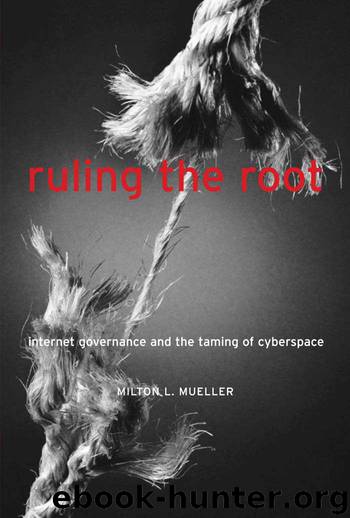Ruling the Root: Internet Governance and the Taming of Cyberspace by Milton Mueller

Author:Milton Mueller [Mueller, Milton]
Language: eng
Format: epub
ISBN: 9780262632980
Google: WMDpnQEACAAJ
Amazon: 0262632985
Publisher: MIT Press
Published: 2004-01-15T02:00:00+00:00
who was not privy to the behind-the-scenes negotiations that created it. It took the form of a nonbinding “statement of policy” rather than a rulemaking document, and it abandoned direct action by the U.S. government. No new TLDs would be authorized. No competing registries would be recognized. No binding decisions about the structure or composition of the new corporation’s board would be made. Instead, the Commerce Department merely announced its intention “to recognize, by entering into agreement with, and to seek international support for,” a new not-for-profit corporation to administer policy for the Internet name and address system. The department would simply wait for “private sector stakeholders” to form a corporation suitable for its recognition. It asked that the private sector be ready with a “consensusbased” proposal in time for the expiration of the Network Solutions contract on September 30, 1998. Ostensibly, it was now up to the warring factions of the Internet to settle the issues.18
Although it allowed the private sector to create what it called NewCo and define its board and structure, the White Paper did prescribe its characteristics in some detail. It should be headquartered in the United States. Its board of directors should be “internationally representative” and balanced to equitably represent various “stakeholders.” These were identified as IP address registries, domain name registries and registrars, the technical community, Internet service providers, and users including commercial entities, noncommercial users, and individuals. Government officials should not be allowed on the board. The White Paper contemplated the appointment of an interim board to jump-start the new corporation. In general, the corporation should be governed on the basis of open and transparent decision-making processes.
The White Paper also described in some detail the policies it thought NewCo should adopt. The Commerce Department pledged that it would revise its agreements with Network Solutions to “take actions to promote competition,” which meant opening up the generic toplevel domains to competing registrars. The globally dominant registry would also be required to “recognize the role of the new corporation to establish and implement DNS policy.” Regarding domain name disputes and trademark protection, the statement abandoned the Green Paper’s registry-centered approach and came out in support of a uniform dispute resolution policy. Moreover, it deferred to WIPO, asking it to initiate a global consultative process to develop recommendations for a uniform dispute resolution system and policies to protect famous trademarks in new toplevel domains. It also called for an independent study to evaluate the effects of new toplevel domains on trademark holders. The work of the IAHC was explicitly recognized.
To those who drafted it, the policy statement outlined a bargain capable of satisfying a coalition of some of the most powerful claimants: the U.S. government; IANA, the Internet Society, and the IAB; the major industry players orchestrated by GIP; the trademark interests; and the European Commission and other involved national governments. Behind the scenes, these groups had made a tenuous peace. The new organization would be “built around the existing IANA.”19 This won the enthusiastic support
Download
This site does not store any files on its server. We only index and link to content provided by other sites. Please contact the content providers to delete copyright contents if any and email us, we'll remove relevant links or contents immediately.
Bad Blood by John Carreyrou(6550)
Rich Dad Poor Dad by Robert T. Kiyosaki(6399)
Principles: Life and Work by Ray Dalio(6207)
Playing to Win_ How Strategy Really Works by A.G. Lafley & Roger L. Martin(5915)
Management Strategies for the Cloud Revolution: How Cloud Computing Is Transforming Business and Why You Can't Afford to Be Left Behind by Charles Babcock(4524)
The Confidence Code by Katty Kay(4187)
Thinking in Bets by Annie Duke(4152)
American Kingpin by Nick Bilton(3755)
Delivering Happiness by Tony Hsieh(3365)
Project Animal Farm: An Accidental Journey into the Secret World of Farming and the Truth About Our Food by Sonia Faruqi(3177)
The Power of Habit by Charles Duhigg(3059)
The Tyranny of Metrics by Jerry Z. Muller(3000)
Brotopia by Emily Chang(3000)
Mastering Bitcoin: Programming the Open Blockchain by Andreas M. Antonopoulos(2981)
The Marketing Plan Handbook: Develop Big-Picture Marketing Plans for Pennies on the Dollar by Robert W. Bly(2975)
I Live in the Future & Here's How It Works by Nick Bilton(2934)
The Content Trap by Bharat Anand(2860)
Building a StoryBrand by Donald Miller(2841)
Applied Empathy by Michael Ventura(2838)
